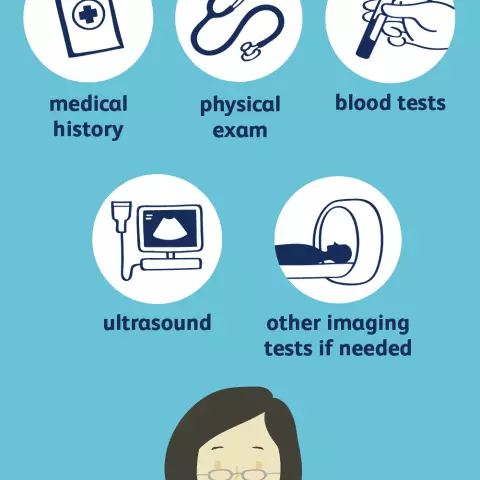- Author Curtis Blomfield [email protected].
- Public 2023-12-16 20:44.
- Last modified 2025-01-23 17:01.
The causes of cholecystitis in humans can be various chronic diseases, or changes in the structure of some vessels of the biliary tract. It can also develop as a result of diseases of the stomach (only those accompanied by dyscholia). The main guideline in determining the disease is the symptom of Kera.

Common symptoms of cholecystitis
Depending on the localization of inflammation or changes in the structure of blood vessels and biliary tract, there are many symptoms of the disease:
- dull pain in the right hypochondrium, which spreads upwards - to the area of the right shoulder blade, collarbone and shoulder; as the disease progresses, the pain becomes more acute and intense;
- nausea and vomiting caused by pain;
- taste of bitterness in the mouth;
- presence of bile impurities in vomit;
- tongue coated and dry;
- possible fever and chills;
- in case of progressiondisease, tachycardia and increased blood pressure are detected;
- if the lumen of the biliary tract is blocked (if there are stones in it), then a person develops pronounced jaundice;
- pain on palpation in the right hypochondrium.

In addition to the above, the main symptom of the disease is Ker's symptom. It is expressed in pain on palpation in the area where the diseased organ is located. As the disease progresses, the pain gets worse and spreads in a less localized manner.
Specific symptoms of cholecystitis
Ker's and Ortner's symptoms belong to the special manifestations of the disease. Further examination occurs after confirmation of the presence of these manifestations. To detect the first symptom, it is enough to conduct a deep palpation of the right hypochondrium, in which case the patient will experience severe acute pain.

Ortner's symptom is detected by tapping the costal arch on the right side with the edge of the palm. In the presence of a disease, all manipulations will be accompanied by painful sensations of varying degrees, depending on how strongly the disease has developed, and what is the age and general he alth of the person.
Besides them, they also distinguish:
- Obraztsov's symptom - when a person inhales during palpation and the pain intensifies;
- Murphy's symptom - inability to inhale with deep palpation in the right hypochondrium;
- Mussi-Georgievsky symptom - whenpalpation of the sternocleidomastoid muscle (in the region of its legs), the patient has a manifestation of painful sensations.
Blood tests may show neutrophilia, leukocytosis, and lymphopenia.
When symptoms appear
Using Kera's symptom, it is possible to determine the presence of acalculous cholecystitis. In the presence of stones in the gallbladder or biliary tract, other symptomatic manifestations are distinguished.

Ker's symptom in acute cholecystitis is the appearance of pain in the gallbladder during deep palpation at the location of the diseased organ.
Disease differentiation
Acute cholecystitis can be differentiated from duodenal or stomach ulcers, as well as acute pancreatitis, appendicitis, or renal colic. In order not to confuse these diseases, it is important to be able to distinguish between them.
In case of peptic ulcers, the pain occurs sharply, besides, it is quite acute, while in case of cholecystitis in the liver area, the pain is dull and increases slightly over time. There is also a temperature in the region of 38 degrees and vomiting with bile.
In acute pancreatitis, pain is localized in the left hypochondrium, and may also be accompanied by continuous vomiting.
Acute appendicitis does not have in its symptoms pain radiating to the shoulder and shoulder blade, and is not manifested by vomiting. With appendicitis, the patient does not have the symptom of Kehr and Mussy.
With renal colic notthere is an increase in temperature and the presence of leukocytosis in the blood. The pain is localized mainly in the lumbar region and spreads to the hips and pelvic organs.
Treatment of cholecystitis
Treatment of cholecystitis should begin before hospital admission. Drugs are administered intravenously that help reduce pain (the most commonly used injection solution is "No-shpy"), and reduce pressure in the gallbladder, due to improved outflow of bile into the small intestine.
Kera's symptom with cholecystitis is the cause of immediate hospitalization of the patient, followed by surgical or conservative intervention by medical staff.
Timely attention to the presence of the described symptoms and the ability to distinguish them from differential diseases increases the chance of a quick recovery without surgery.






